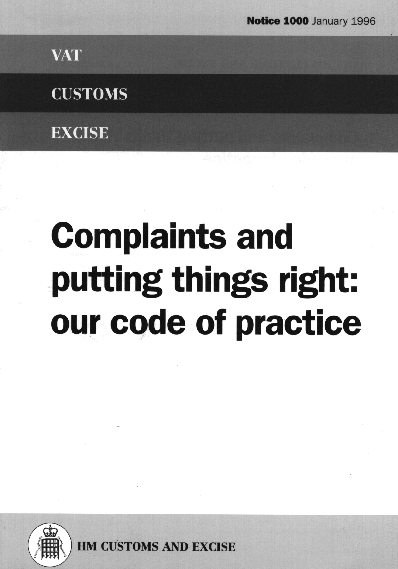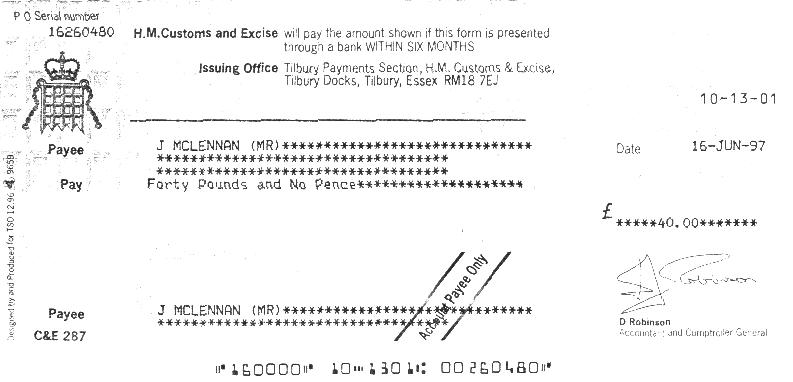Memoirs of an Invisible Man
My career as a part-time trespasser was born out of two events, starting with a desire for a free lunch. I work for a multinational in the City, and while we had to buy sandwiches, at one of our sister companies, they got lunch supplied. Some bright spark eventually realised that you could hijack this facility by going in and flashing your pass; even though it was technically invalid, no-one would ever stop you, if you did it with the necessary cheek.
The second incident was getting sent to one of our other offices; I got the address confused and walked into the building next door. Again, a flash of the pass and I was in, even though it belonged to a totally different company. It took ten minutes to work out why I couldn’t find our office, but I got to wondering just where I could reach by sheer effrontery. Since then, I’ve explored many major buildings in the City, including Lloyds, the Nat West Tower and the Guildhall, and wandered round without real interference.
It’s a great way to spend your spare time, providing the necessary adrenalin buzz to counteract the dull afternoons, and you get a fascinating glimpse into the way the other 99.95% live. The odds are well stacked against any significant sanctions as a result of your actions, and really, it’s so simple that anyone with an average degree of common sense can do it. And much of what follows is no more than that, but it probably bears explicit repetition.
1. Selection of your target.

In general, the bigger the building, the better. With 1000 people, it’s hard for any guard to recognise everyone, and even the eidetically memoried will still have to deal with staff turnover and all those people who are there legitimately. A busy place is preferable to one with little activity. The more people going in, the better, as you’ll be exposed to proportionately less scrutiny.
Obviously, some places are more open and accessible than others, but the level of security at the front door varies surprisingly little: a couple of security guards are usually about all there is, unless the business of the building requires special protection. Eventually, even these may become viable for the experienced wanderer, but for the novice, it’s better to start with easier targets.
2. Advance preparation
You should be as familiar with the place as a “real” inhabitant — it’s a dead giveaway if you arrive, then walk into a broom cupboard! Most places have a foyer where you can wait, and sitting here will let you watch people going in, and learn things like: to whom they show their passes; what do they do after going past security; where are the stairs and the lifts? This will also allow you to check for internal security, such as turnstiles and passcard doors. The latter aren’t a problem (see below), the former are tough to defeat but are rare. You’re more likely to find them in offices that aren’t open to the public because they make that carefully designed airy atria look more like a football stadium, and distinctly unwelcoming.
Through observation, you will also learn which time of day is best. You want to follow the herd in, so early in the morning, or at the end of lunchtime are good times, allowing you to ride on the ratio of workers to security personnel. For this reason, evenings and weekends are pretty much ruled out; the building may be just about deserted, but you’ll have individual attention from whoever is on duty. Bear in mind that different buildings run to different schedules: stockbrokers start work earlier in the morning than bankers.
3. Appearance
This extends to a little more than the obvious; you’re not going to get far into the Stock Exchange wearing jeans and a T-shirt, but if you need to be told that, you’re not going to get far anyway. What this really involves is the stuff round the edges; if you are going into a building at lunch-time, carry a paper bag of sandwiches. If it’s morning, a briefcase may help, but at 3:20 will mark you down as a visitor. Perhaps there’s a standard sort of clothing, except on Fridays, which are dress-down days; a little care will establish what is the best approach to take.
4. The hit.
For the purposes of this introduction, we will assume a standard building where you have to present a pass to someone just inside the front door. There are four basic ways of getting in, which have advantages and disadvantages. In roughly increasing order of risk, they are:
- (a) Semi-legitimate access
- (b) A forgotten pass
- (c) Using dodgy ID
- (d) The fake visit
(a) is simply using a pass obtained previously, which you didn’t hand back when you left. Few have a date or other limitation on them; even one which says “4th Floor” can be taken off at an opportune moment as soon as you get inside. Rules about wearing these are rarely enforced with any firmness: it’s certainly better to wear no badge, than wear one which immediately marks you as a visitor outside his territory.

The next approach is to pretend you’ve forgotten your ID. This happens to everyone, especially on Monday mornings (“I left it in my other suit”), or after lunch (“It’s in my drawer”). You’ll probably have to sign in at reception instead, so have a convincing fake name and a mumbled apology ready. You may well get a temporary pass, which can be kept for a future visit.
While the above two methods are relatively safe, the next one is risky. You flash something on entrance that looks legitimate, but isn’t. The aim is to minimise the amount of time your fake ID is visible; ideally, zero. If you appear to have shown a pass, the guard may simply assume that you have done so, and will not hassle you. Certainly, you’ve a better chance than if he thinks you’ve tried to sneak past him. Timing is essential, if the guard is otherwise distracted, you can sweep past like a clipper in full sail. It goes without saying that what you flash should vaguely resemble the real thing, so it helps to have seen an example beforehand. In general, it should have your picture on it in the right place, and be roughly the same size.
The final method is really for the daring, and requires you to pretend you have an appointment with an inhabitant. It’s tricky because you have to know the name of someone in the building, and you must hope that you get sent up to see them, rather than them coming down to meet you! Of course, once in the lift, you can get off elsewhere, leaving them puzzled but not too bothered. If you do get held in reception, a rapid exit is your best option. One excellent, plausible alternative is claiming to be a photocopier repairman; just give a floor, and say there was no contact name.
For all of these, the key requisite is confidence. If you look like you should be there, you won’t have any problems. Seem unsure of where you’re going, and you stick out like a sore thumb. First impressions are crucial here: walk boldly past the entrance guard with a smile. Knowing his name, whether through prior observation, or his badge, is a major bonus; if he thinks you know him, it’s a major psychological hurdle to overcome.
5. Once inside
When you’re in the building, most of your problems are over; the chances of being stopped are slim, especially if you keep moving, and (as above) are confident about it. Best only to stop in communal areas, near coffee machines, lifts, or photocopiers, where hanging round is acceptable, and less suspicious. In terms of security, you may find passcard doors, whose locks require the application of a smart card or pass to open. The answer to these is the technique known as “tailgating”, in which you follow a legitimate worker through the door. Most people, placing politeness above security, will hold it open for you — especially if you have your arms full with a (possibly spurious) cardboard box. Smile gratefully at them as you head into the restricted area.
6. If you get caught

Even so, sooner or later, someone will become suspicious of your behaviour. Unless they are extremely sure of their ground, their reaction will probably be along the lines of “Can I help you?”, and it’s best to have an answer for this prepared. The ubiquitous photocopier is convenient, or you can claim to be looking for a spurious person — pick a less common name, as the last thing you want is to find there actually is someone called that around! If the building is occupied by more than one company, you can pretend to be on the wrong floor.
You have to be very, very blatant before an employee will even think about notifying security, and people are generally leery of mounting any challenge, as the potential losses outweigh the benefits. Most folk just don’t care. Of course, if you get caught at the front door, you’ll be face to face with security, and your tactics need to be a little different. It’s best to write off the occasion, and possibly the entire building (after all, there’s not exactly a shortage!), so make your excuses and leave. Pretending to be in the wrong building is good, just get the address slightly wrong, and affect surprise. It is, however, a bit tricky to do this if the foyer features a big logo for the company in question.
Almost certainly, the worst that will happen is that you will be asked to leave. Few companies want to create a fuss over simple trespass, and unless you’ve caused damage or broken the law in other ways, you’ll just be shown the door. It’s not worth the hassle for you or them, to extend the confrontation: just leave quietly. There’s little doubt that your face will be remembered, so don’t even think about revenge, unless you are incredibly fool-hardy.
7. And the point is…?
You may be wondering, why bother? This is the hardest facet to describe: it’s easy to teach someone how to elude security, but they have to come up with their own reasons why. I could, if I wanted, loot a huge pile of stuff, but I don’t bother — all offices are much the same, and if you’re going to boost stuff, it’s easier to do it from your own work-place!
If I had an axe to grind against a company, I could create chaos, by setting off the fire alarms, for example. [It’s also worth noting that after a fire drill, as the employees flood back in, security checks tend to be ignored] Realising just how lax most companies are, is something of a salutory experience. However, I am a good capitalist, and any such campaign would eventually backfire on me, as places started to get tough.
I do it merely for the excitement; it’s like exploring a new country, complete with the threat of hostile natives. I’ve seen brilliant views from the top of some of Britain’s tallest buildings; I’ve chatted to everyone from executives to cleaners; I’ve stalked the corridors of power in banks, newspapers, computer companies and hospitals. It is good to realise just how dumb the glorified bouncers in these places can be.
The next time you see a strange face lurking in a slightly suspicious manner by the photocopier, you never know who it might be. Go up to them, stare them straight in the eye…and ask them when the machine will be fixed!
“Arsene Lupin” was talking to Jim McLennan.









